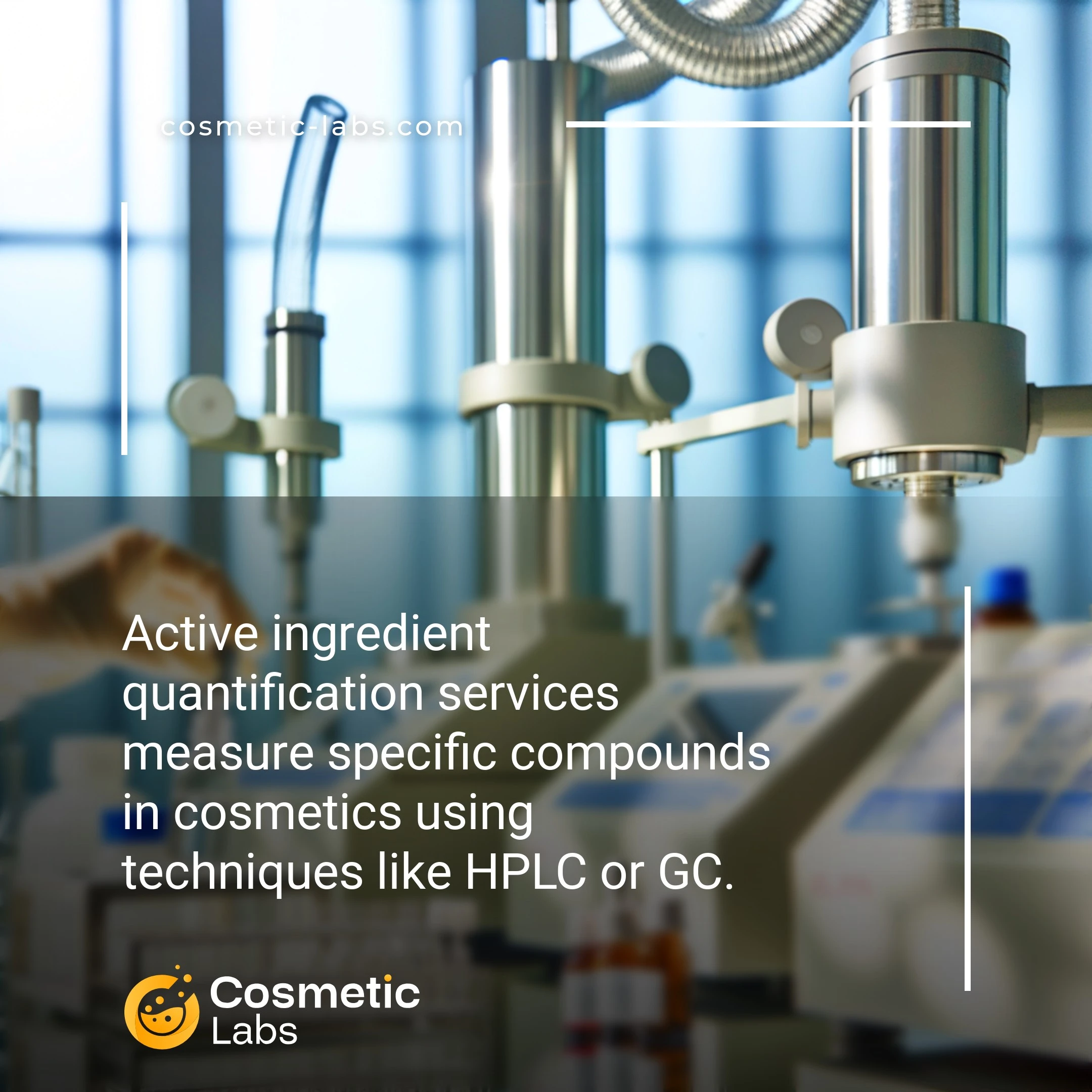Active Ingredient Quantification Services for Reliable Cosmetic Testing

What is Active ingredient quantification?
Active ingredient quantification services measure the exact concentration of key compounds in your cosmetic formulations using HPLC, GC-MS, and UV-Vis spectroscopy. Labs verify that your vitamin C serum contains the claimed 15% ascorbic acid or that your retinol cream delivers precisely 0.3% active retinoid—testing that protects both product efficacy and regulatory compliance. Most brands don’t realize that ingredient degradation during storage can reduce active levels by up to 30%, making periodic quantification testing a smart investment.
Why do you need this service?
Cosmetic labs use active ingredient quantification to verify retinol concentrations match label claims and ensure vitamin C remains stable throughout shelf life. Brand owners rely on these precise measurements to prove their 2% niacinamide serum actually contains 2% niacinamide, protecting against regulatory issues and customer complaints. Labs also track ingredient degradation over time, helping you determine accurate expiration dates and adjust formulations before production scales up.
Who provides Active ingredient quantification services?
All cosmetic labs providing Active ingredient quantification services
There is no company providing these services at the moment.
Active Ingredient Quantification Services
Cosmetic labs offer active ingredient quantification to verify that your formulations contain the exact concentrations of key ingredients listed on your labels. These analytical services form a critical part of preclinical characterization, helping you meet regulatory requirements and maintain product consistency.
Testing Methods and Capabilities
Labs use validated analytical techniques to measure active concentrations with precision. HPLC (High-Performance Liquid Chromatography) remains the gold standard for quantifying ingredients like retinol, vitamin C, and peptides. UV-Vis spectroscopy works well for simpler compounds.
Common quantification services include:
- Vitamin analysis (A, C, E, B-complex)
- Peptide and protein content verification
- Botanical extract standardization
- Preservative system confirmation
- Active pharmaceutical ingredient (API) testing
Most labs provide results within 5-10 business days, with rush options available for product launches.
Quality Control and Batch Verification
Beyond initial formulation testing, labs help establish quality control protocols for production batches. They develop specific methods for your unique ingredients and create acceptance criteria based on regulatory guidelines.
Batch verification services typically cover:
- Raw material identity confirmation
- Finished product assay (90-110% of label claim)
- Stability testing at multiple timepoints
- Certificate of Analysis generation
Labs can also validate your in-house testing methods, ensuring your quality control team gets accurate results. This partnership approach helps you maintain consistent product quality while meeting FDA and international standards for cosmetic manufacturing.
Real-World Applications of Active Ingredient Quantification
Precise measurement of active compounds drives product performance claims and regulatory compliance across beauty formulations.
Quality Control During Scale-Up Production
Labs use active ingredient quantification services to verify concentration consistency when transitioning from bench-top batches to pilot runs. HPLC analysis confirms that a 2% niacinamide serum maintains its potency whether you’re producing 100 units or 10,000.
Temperature variations and mixing speeds during scale-up can affect ingredient distribution. Quantification testing at multiple production stages catches concentration drift before it impacts product efficacy.
Stability Testing for Shelf Life Determination
Cosmetic labs track active ingredient degradation over time using accelerated aging protocols. A vitamin C serum might start at 15% L-ascorbic acid but drop to 12% after six months at 40°C.
Regular quantification reveals degradation patterns that inform packaging decisions and expiration dating. Labs test samples monthly, documenting how pH shifts and temperature exposure affect potency.
| Testing Method | Active Ingredients Analyzed | Typical Turnaround | Detection Range |
|---|---|---|---|
| HPLC-UV | Retinoids, AHAs, BHAs | 3-5 days | 0.01% – 30% |
| LC-MS/MS | Peptides, ceramides | 5-7 days | 0.001% – 10% |
| UV-Vis Spectroscopy | Sunscreen actives | 1-2 days | 0.1% – 25% |
| GC-MS | Essential oils, fragrances | 4-6 days | 0.01% – 5% |
Partner with specialized cosmetic labs on our platform to implement rigorous quantification protocols that support your product claims and regulatory submissions.
